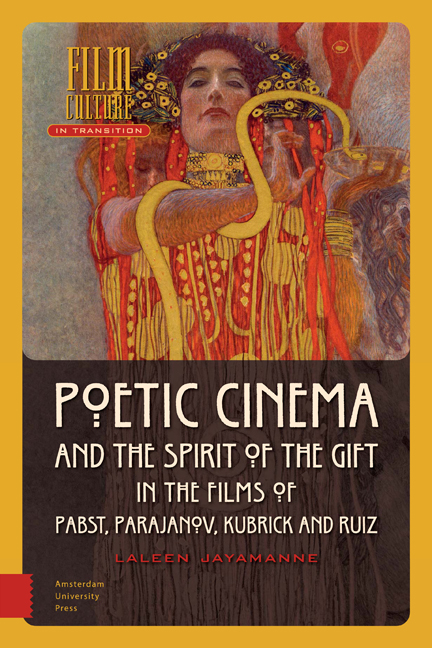Book contents
- Frontmatter
- Dedication
- Contents
- Foreword: In Memory of Thomas Elsaesser
- Introduction: Spirit of the Gift: Cinematic Reciprocity
- 1 A Gift Economy: G. W. Pabst’s Pandora’s Box (1929)
- 2 Fabric of Thought: Sergei Parajanov
- 3 Nicole Kidman in Blue Light: Stanley Kubrick’s Eyes Wide Shut (1999)
- 4 Ornamentation and Pathology: Raúl Ruiz’s Klimt (2006)
- Afterword: Poetics of Film Pedagogy
- Bibliography
- Filmography
- About the Author
- Index
Foreword: In Memory of Thomas Elsaesser
Published online by Cambridge University Press: 13 April 2021
- Frontmatter
- Dedication
- Contents
- Foreword: In Memory of Thomas Elsaesser
- Introduction: Spirit of the Gift: Cinematic Reciprocity
- 1 A Gift Economy: G. W. Pabst’s Pandora’s Box (1929)
- 2 Fabric of Thought: Sergei Parajanov
- 3 Nicole Kidman in Blue Light: Stanley Kubrick’s Eyes Wide Shut (1999)
- 4 Ornamentation and Pathology: Raúl Ruiz’s Klimt (2006)
- Afterword: Poetics of Film Pedagogy
- Bibliography
- Filmography
- About the Author
- Index
Summary
An email from Amsterdam University Press, dated 4 December 2019, informed me that Thomas Elsaesser – whose work has been of fundamental importance to me as a film scholar since the late 1970s – had endorsed my book proposal for the series he edits, Film Culture in Transition. Soon after, I heard that Elsaesser had suddenly died on that very day in Beijing, where he was on a visiting professorship. This uncanny coincidence, of what appears to me to be an endorsement by death, immediately reminded me of my treatment of the death of the Sufi minstrel, his astonishing manner of dying, and his burial between a rock and a hard place, in Parajanov's Ashik Kerib. It is this chapter on two films by Sergei Parajanov that I sent as a sample of my writing, which I know Elsaesser had read. The following passage on death now appears in Chapter Two of this book.
There are a great variety of ways of dying on film, some spectacular and violent, some sensuous, others quiet, soft even, some almost imperceptible, so much so that I feel that death awaited film to find its full, capacious, expression in all its magnitude. Its cross-cultural expressions on film are profoundly creative, diverse. One could not say the same of birth on film which mostly seems to be reduced to its existential physical coordinates, screaming or groaning, perhaps a brief silence, shattered by the wail of the new born.
I now feel that death has cast its shadow over this project. Does death have a shadow? Death is shadow-like. Elsaesser has shown us how and why Weimar cinema invested the shadow with vitality, a non-organic life which displaced the opposition of the organic and the inorganic. Parajanov's The Colour of Pomegranates presents us with the Angel of Death, who arrives as a blindfolded, stumbling, winged soldier, to present the poet Sayat Nova with a parcel of earth wrapped in a piece of unleavened bread. The usual solemnity and fear accompanying the arrival of death is undone in these scenes of levity, in which two boy angels push and pull the Angel of Death towards the poet, in an ancient Armenian Apostolic Christian cemetery.
- Type
- Chapter
- Information
- Poetic Cinema and the Spirit of the Gift in the Films of Pabst, Parajanov, Kubrick and Ruiz , pp. 9 - 12Publisher: Amsterdam University PressPrint publication year: 2021



